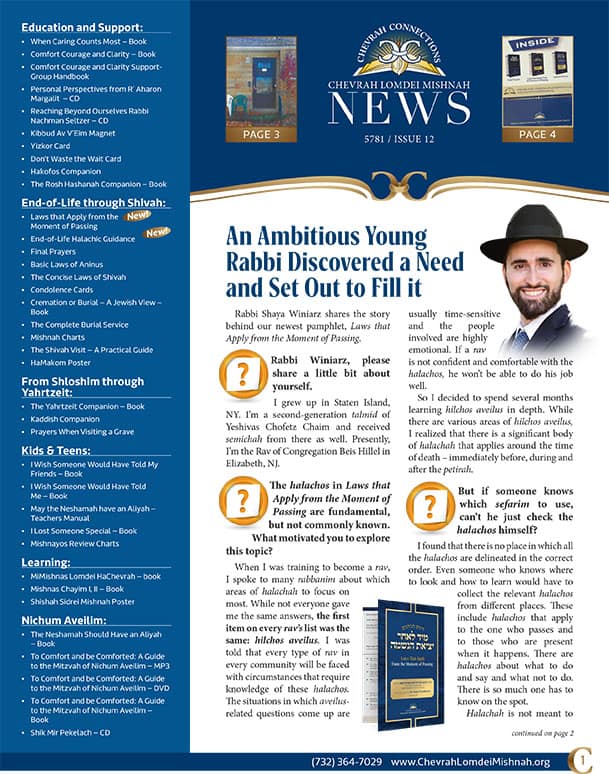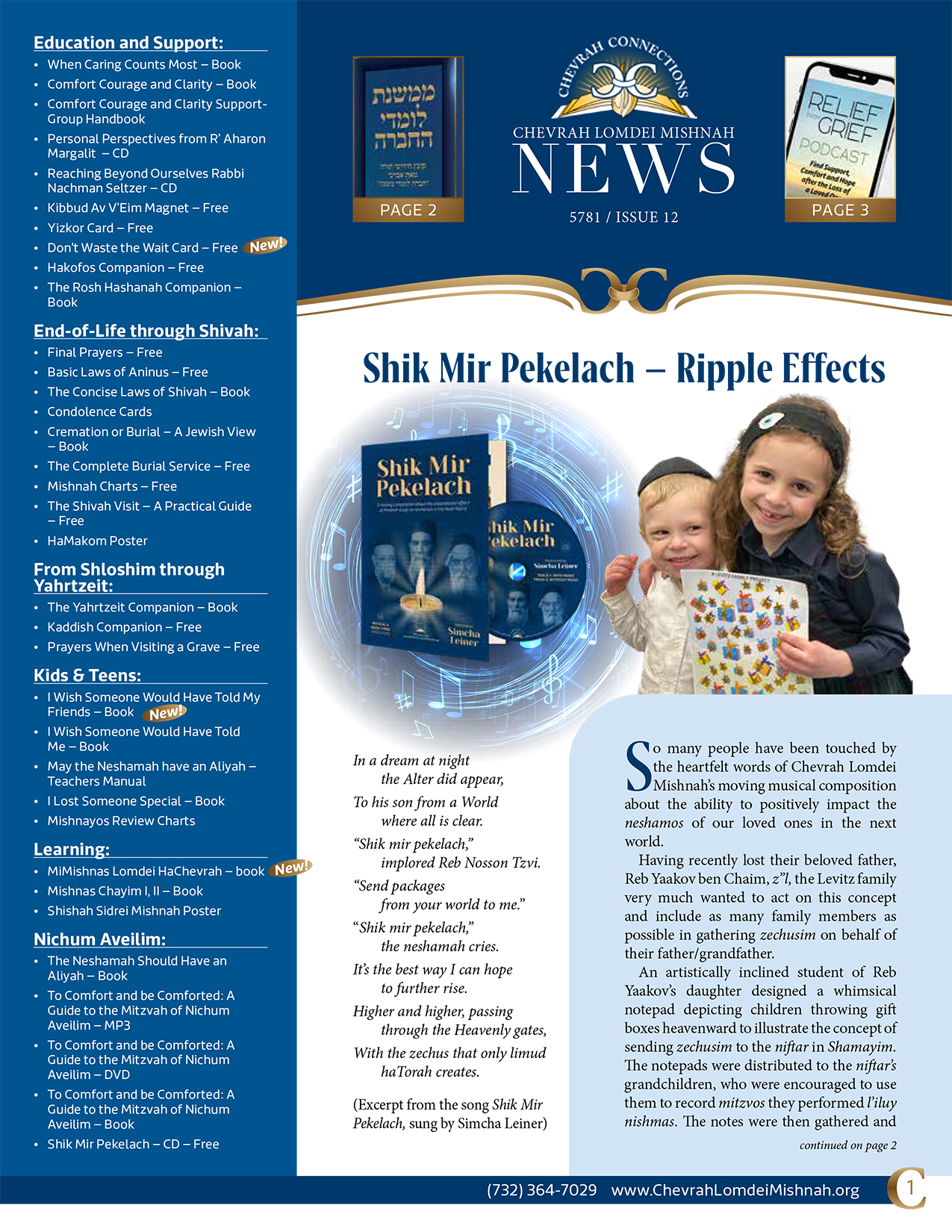Inyan – Hamodia Weekly Magazine
Loss of a loved one is a pain-filled experience. Yet it is comforting to know that it is possible to maintain a link with that individual and what he or she achieved in this world. Family members can strive to transcend the pain and send pekalach, “packages,” of the merits of learning Torah and performing mitzvos through which the neshamah is elevated in the next world. And often, arranging for these “packages” to be sent heavenward results in the unexpected.
Approximately two years ago, Arnold, a man from a secular family in Las Vegas, Nevada, passed away. The man’s children intended to have his body cremated. However, his observant niece in Scottsdale, Arizona, Mrs. Robin Meyerson, aware that this decision was contrary to halachah, was understandably distraught over this decision and tried to convince the relatives in charge to change their plans and have him buried. She contacted Rabbi M. H. of Lakewood, founder and director of Chevrah Lomdei Mishnah, for guidance. At the same time she requested
that Mishnayos be learned l’iluy nishmas her uncle.
That night Arnold appeared in a dream to his astonished daughter Valerie, a cousin of the observant niece and the executor of the will, and requested not to be cremated. At that point Mrs. Meyerson’s input was more seriously sought to change the plans. Shemirah was arranged to fulfill the halachah not to leave a body unattended between death and interment, and ultimately the man was given a Jewish burial.
About a year later Rabbi H. was invited to travel to Scottsdale to be the sandak at the bris of her new son, Azriel Mordechai, who was born on Shushan Purim, the day of her Uncle Arnold’s first yahrtzeit. Mrs. Meyerson’s cousin, Valerie, awestruck by the turn of events, undertook to learn about the laws pertaining to Jewish funerals and has begun volunteering to sit with the Jewish deceased, as someone once sat with her deceased father.
Mrs. Meyerson said, “Rabbi H. taught me the meaning of Kaddish and the study of Mishnayos for the departed; he played an instrumental part in the burial of my uncle, of blessed memory. One of my primary missions in life has now become to share my newfound knowledge
of the beauty of a proper Jewish burial and our timeless mourning customs and halachos with Jews not yet connected to Torah.”
Addressing a Need
Several years ago Rabbi Moshe H., an alumnus of Yeshivah Ner Yisrael in Baltimore and who is still learning in Lakewood’s Beis Medrash Govoha, was approached by an acquaintance to learn Mishnayos on behalf of a relative who had passed away shortly before. Rabbi H., a graduate of the National Council of Young Israel’s rabbinic training program, was aware that many people were not familiar with the customs that provide merit for their departed loved
ones. He realized that even among those knowledgeable in this area, many are not capable of studying Mishnayos, Gemara, or other sefarim, and those who can often don’t have the time, and wish to commission a Torah scholar to undertake a study commitment in their stead. In 2006 Rabbi H. established Chevrah Lomdei Mishnah, The Society for Mishnah Study, to enable Jews of various levels of religious observance to access this service by assembling a team of Torah scholars to study Torah and pray on their behalf.
The Chevrah offers several basic study options. They can learn a set amount of Mishnayos or Gemara to be finished by a particular date. Alternatively, they can complete a particular limud — perhaps a masechta or even the entire Talmud — independent of a time frame. Yet another
possibility is to request the learning of a specified amount of Gemara or Mishnayos for forty days. Jewish tradition views the period of forty days as significant since Moshe Rabbeinu mastered the entire Torah during his forty-day sojourn on Mount Sinai.
The Stories Abound
Those involved in the Chevrah Lomdei Mishnah have seen indisputable hashgachah pratis in carrying out their sacred mission. A certain benefactor once sent in two contributions, one to sponsor Talmud study in honor of his father’s yahrtzeit and a second to provide merit for
any other deceased Jews in need of zechuyos. A few days later, the Chevrah learned of the upcoming yahrtzeit of a young man who had passed away a year earlier under tragic circumstances. They applied the extra contribution to provide Mishnah study l’iluy nishmas the young man. When the Chevrah representative told the donor how his extra contribution was to be used, he was clearly in awe. “That young man was my next-door neighbor,” he said. Requests for the services of Chevrah affiliated scholars are not limited to learning on behalf of departed loved ones; people also seek them as a zechus for Divine assistance in a variety of challenging situations. Through the Chevrah, people have received help in a variety of difficult situations, such as a refuah sheleimah for the ill, a shidduch, the blessing of children, or a livelihood. Rabbi
H. recalls that there were several instances of women who succeeded in obtaining a Jewish divorce from recalcitrant husbands after a concerned party sponsored a learning program in
their merit. In one such case, one forty-day learning plan was requested, then a second. The woman received her get on the fortieth and final day of the second cycle. In a second case, two consecutive forty-day cycles took place on behalf of a woman whose chances of receiving a get were deemed remote since her former husband had abandoned Yiddishkeit. Toward the end of the second cycle the man started demonstrating interest in cooperating with those involved in arranging the divorce. A third cycle — this time of ten days — was arranged, at the completion of
which he divorced his wife according to halachah.
In one of the Chevrah’s more unconventional stories, a non-Jew from a foreign country requested that Torah be learned as a merit for his success with his livelihood. The individual related that for
the last decade he had been seriously studying the Bible and reading up on Torah topics using English-language Judaica resources. Rabbi H. sought halachic guidance regarding the fulfillment of the man’s request. With rabbinical directives, the Chevrah has arranged a number of
learning programs for him over a period of several years. Rabbi H. was gratified to hear that the Chevrah’s initiatives have helped the man strengthen his ability to support himself.
As they carry out their study commitments, the scholars of Chevrah Lomdei Mishnah have an impact on those they assist, as well as on others. One of their most memorable events was a siyum haShas that took place in Teaneck, New Jersey, to mark the yahrtzeit of the head of a family from El Paso, Texas. His son, who was learning in a kollel in Yerushalayim, desired to do something in conjunction with his father’s first yahrtzeit. He had presented the idea of a siyum haShas to several family members who agreed to help sponsor the project under the Chevrah’s auspices. Besides serving as a tremendous zechus for the niftar, the siyum brought together
the talmidei chachamim who had undertaken the learning with Jews from across the spectrum of Yiddishkeit who lived in Yerushalayim, Teaneck, El Paso, St. Louis, Lakewood and other cities, in an impressive show of achdus and kevod haTorah.
On a Broader Scale
On Tzom Gedaliah of 2011, the Chevrah was involved in a siyum Mishnayos at the Bialystoker Synagogue on Manhattan’s Lower East Side to commemorate the tenth anniversary of the September 11th terrorist attack on the Twin Towers, which was dedicated to the memory of the victims. Several other shuls and individuals partnered with the Bialystoker Synagogue and the East Side Torah Center to make this special event possible.
Chevrah Lomdei Mishnah is also involved in educating the public about the fascinating yet esoteric topic of providing merits for the deceased. A book called The Neshamah Should Have an Aliyah by Rabbi Tzvi Hebel was published in 2009 by Judaica Press in conjunction with the Chevrah. It discusses the concept of providing merit for the departed and provides practical direction about various ways to bring about an aliyas neshamah according to classical Torah sources. A second volume, Mishnas Chayim, consists of Torah thoughts and insights that connect the weekly parashah with relevant Mishnayos. These insights are based upon the Chevrah’s weekly newsletter of the same name, which has been disseminated in shuls for several years, as well as via email.
Mitzvos That Elevate the Soul
Yaakov Avinu requested that after his death, his son Yosef remove his body from Egypt and take it for burial to the Me’aras Hamachpelah, the cave housing the tombs of the Patriarchs, in Eretz Yisrael (Bereishis 47:29). He termed this act a chessed shel emes, a completely altruistic kindness of truth, since it was one he could never repay. Harav Eliyahu Guttmacher (1796-1874), zt”l, in his sefer Sukkas Shalom, extrapolates from this by saying that if burying a person’s body, which is merely the “garb” of the neshamah, constitutes an extraordinary act of kindness, how much more so is the performance of deeds that offer the spiritual means for a neshamah to become elevated in the World of Truth. There are a number of mitzvah activities that achieve this goal. Among them are prayer-related involvements such as reciting Kaddish and leading prayers as a shaliach tzibbur, donating tzedakah, performing acts of chessed, and studying Torah. The consensus of halachic authorities is that Torah study, which is considered primary among the mitzvos, is the most effective means to bring merit to the deceased. It is empowering to know that the impact and potential of our avodas Hashem is so broad in scope that the learning and mitzvos we perform in this world have the capacity to be credited to the departed in the World of Truth.
Connecting to the Past
Earlier we mentioned that assisting a niftar is a chessed shel emes, an act of kindness the recipient can never repay. Yet such acts do redound to the one who performs them in the sense that they constitute a valuable opportunity to connect to the past. One of the Chevrah scholars, Rabbi Avrohom Yitzchok Ausband, recalls that he once undertook a learning project for a woman who he was told had been in four Nazi concentration camps. For him, it was especially meaningful since he had grandparents who had also been incarcerated under the Nazis, ym”s. “It’s a tremendous zechus and hischayvus [sense of obligation] for me, and I feel connected
to these people,” he said. In accepting this commitment, he felt a renewed desire for growth in Torah and ruchniyus. Such is the power of this connection one can forge with Jews of previous generations. In times of tragedy or in times of difficulty, people seek meaning. It is an immeasurable source of comfort to know that the Torah we study and the mitzvos we perform provide invaluable merit, both for the departed and for those they have left behind. In doing so, we are inspired by their legacy to strive to emulate their worthy deeds and to sanctify Hashem’s Name in this world.
Learning as a Source of Merit
It is universally accepted that the best way to generate merit for the departed is to study Torah in their name. It is also known that there are some Torah topics that have special potency in benefiting the neshamah. The study of Mishnayos stands out in this respect. The Aruch
Hashulchan and others write that the learning of Mishnayos causes a “tikkun gadol,” great rectification, for the neshamah, alluded to by the fact that when the letters of the word Mishnah —mem, shin, nun, hey — are transposed, they spell neshamah. (See also the sefer Pnei Baruch 39:13, with note 25.) Mishnayos study has the power to cleanse the soul of sin, as the Chida and others attest.
There are various customs for how to conduct the learning of Mishnayos. One way is to select chapters of Mishnayos that begin with the letters of the name of the niftar. For example, if his name was Avraham, one would first select a chapter that begins with the letter alef, perhaps the fifth chapter of maseches Brachos, which begins with the words “Ein omdim.” One could then learn the fifth chapter in maseches Shabbos, whose opening words are “Bameh beheimah yotz’ah,” which starts with a beis, the next letter in the name Avraham. (A table of chapters of the
entire Mishnayos listing their initial letters for this purpose can be found in the Yachin U’Boaz sets of Mishnayos.) During shivah, the learning is not done by the mourner, who is prohibited from studying Torah at that time, but by others.
There is a well-accepted custom to have entire Shishah Sidrei Mishnah completed by the end of the first thirty days of mourning, the sheloshim, by the end of the first year of mourning, or in subsequent years on the occasion of the yahrtzeit.
Study of the entire Talmud is also sometimes undertaken, to be finished on the yahrtzeit. Relatives, friends, and acquaintances are asked to commit to learning one or more tractates whose study will culminate in a siyum. When relatives of the niftar are unable to study due
to inability, time constraints, or other reasons, they often choose to have someone else do so. Regarding the remuneration that is proffered for such learning, poskim have said that if the learner is a talmid chacham, the merit is magnified since the deceased is also credited with
helping to support a Torah scholar.
For more information and various sponsorship opportunities, contact Chevrah Lomdei Mishnah at 732-364-7029 or at ChevrahLomdeiMishnah.org.
– October 2012













